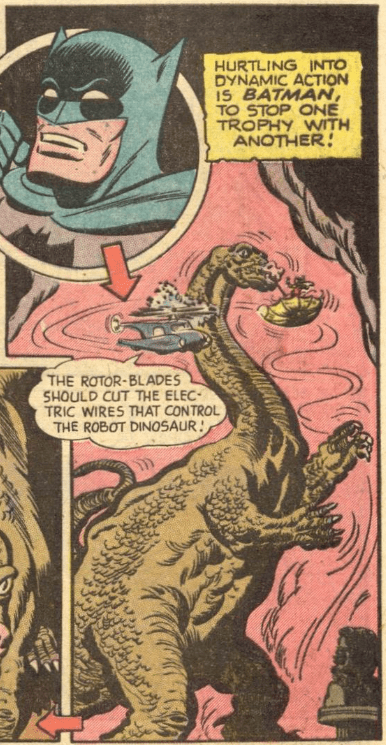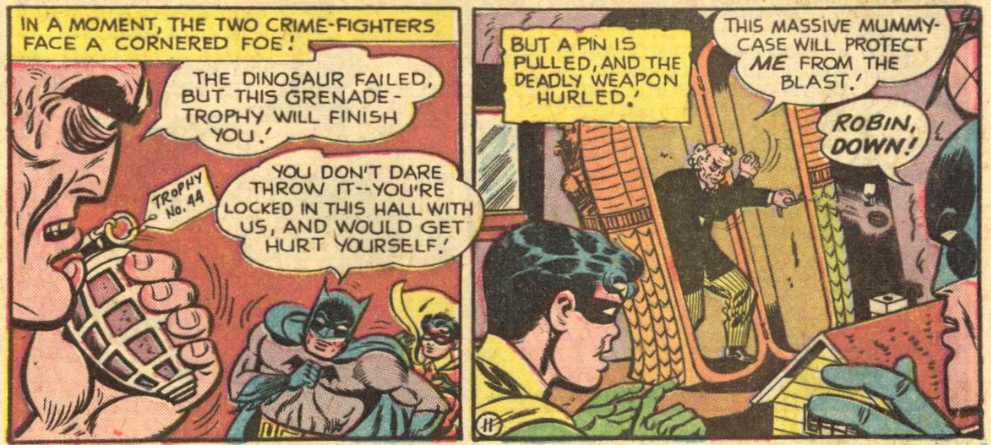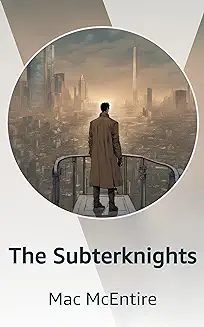Reading the Fantastic Four comics from the start. Before we get into the storyline about Dr. Doom’s mentor, it’s finally time to look back at the first Dr. Doom. That means this week we’re reading… DC Comics???
Most comic book fans have heard occasional whispers that DC also has a character named Dr. Doom, but just who is this character? He first appeared in Detective Comics #158 in 1950, more than ten years before Marvel introduced its Dr. Doom. I’ll give Stan Lee and Jack Kirby the benefit of the doubt, assuming they were unaware of one old comic book rather than them stealing from DC. Either way, just who is DC’s Dr. Doom?
We begin with Batman and Robin entering the Batcave’s trophy room, with various items they’ve collected in their crimefighting adventures. They’re celebrating having collected their one-thousandth trophy, the sound of a musical note trapped in glass, which, if heard, is able to kill a man. They give themselves a little tour of the other trophies, including the giant penny and dinosaur, as well as giant dice, a chessboard, an experimental helicopter, a harpoon gun, and even an empty trophy case that was once instrumental in establishing a man’s innocence. Robin jinxes things by saying that after a thousand trophies, maybe he and Batman can take the night off, but then they get an alert from Commissioner Gordon.
Gordon, via the Batmobile’s radio, tells Batman that a “smuggling-leader” named Dr. Doom was spotted at Gotham City’s Pier 16, where a ship, the Queen Maude, has just arrived. Batman says he’s been pursuing Dr. Doom for a long time, but the villain has been too clever, so that Batman can’t nab him in the act. At the docks, we get our first very tiny glimpse of Dr. Doom:
Batman deduces that the Egyptian antiques on the ship are fakes, being used to smuggle jewels illegally into the country. Dr. Doom, with his cigarette in his mouth, dives into the ocean. Turns out his cigarette holder his breathing tube, allowing him to survive the ocean depths. Commissioner Gordon believes Dr. Doom is dead, while Doom instead sneaks back onto the docks and hides inside an empty mummy case. (Not a sarcophagus, only a “mummy case.”) Gordon knows that Batman likes to keep trophies from his cases, so he lets Batman keep the mummy case as trophy number 1,001. The Dynamic Duo place the case inside the Batcave and leave. Then, finally, seven pages into the story, we see Dr. Doom’s face in closeup for the first time:
Doom wants to take over the Batcave and make it his headquarters, except that he’s locked inside the trophy room. He plots to use the other trophies as deathtraps for Batman, and then he short-circuits the Batcave’s alarm to get Batman’s attention. The alarm goes off, so Bruce Wayne and Dick Grayson but their bat-suits back on and return to the Batcave.
As the heroes investigate, the container holding the giant dice activates, throwing the dice at Batman. Batman ducks out of the way while Robin deduces the dice mechanism had a cut wire. Then the giant penny almost drops on Robin, and the harpoon gun fires at Batman. Fortunately, our heroes are skilled enough to avoid these dangers.
Robin wonders if all their old enemies have returned, but Batman does detective stuff, checking the Batcave’s security cameras. He’s reminded that the mummy case arrived earlier that day. They check the case, only to find it empty. But, Batman finds water inside the case, deducing that Dr. Doom hid inside there after surviving being in the ocean. While they’re figuring things out, Dr. Doom watches them from his hiding place inside the robot dinosaur.
Then the dinosaur attacks, under Doom’s control. It fights Batman and Robin on the giant chessboard, for some classic Silver Age whimsical weirdness. Batman uses the experimental helicopter to fight the dino, cutting the wires that control it. With the dinosaur now useless, Doom escapes it and grabs a grenade, which is trophy #44. He pulls the pin, despite Batman’s warning that it could destroy them all. (Batman didn’t disarm this thing before he put it in the trophy case?) Doom hurls the grenade to the center of the room while he hides safely inside the mummy case.
Batman smothers the grenades blast by using another trophy, a small mansion that was once home to a group of miniaturized people. Batman says now that Dr. Doom is inside the mummy case, they know where he is, and they can take him to the police. But then, Batman discovers that the grenade blast sealed the mummy case shut, with no air inside. Batman tries to chisel the mummy case open, but it’s no good. He can’t get it open, and Dr. Doom suffocates to death (!). The mummy case, with Doom’s corpse inside it, is placed inside the Batcave as trophy number 1,001. Batman ends the story on a grim note when he says, “The one that brought death into our hall of trophies – death that recoiled on its plotter!” (And people say these Silver Age comics were all kid-friendly and squeaky-clean.)
That’s it for that story, but this comic book is a 52-page monster. The next story is “Impossible But True,” the adventures of Roy Raymond, a.k.a. the man of 10,000 facts, who is the host of a TV science show. He and his girlfriend Karen investigate a scientist named Dr. Wellington, who claims to be able to combine aircraft and teleportation, only to have someone die aboard a test flight. There are lots of twists and turns before Raymond uncovers the real killer.
In the next story, we have Robotman, star of Doom Patrol, in a solo adventure. Some crooks pose as charity fundraisers, who then take their donations to spend at a fun day at a carnival. Robotman, in his “plastic disguise” as human Paul Dennis, catches onto them. There’s a lot of comedic antics as Robotman and the crooks chase each other around the carnival, before ending with a fight atop a roller coaster and the final confrontation in the house of mirrors.
Then there’s “Dover and Clover,” a comedy story about two identical twins who are bumbling detectives. They accidentally stop a jewel store manager stealing from his own store, but not after they go the zoo and back. This is followed by a text piece called “Winner Take All No. 2” with guidelines for some sort of trivia game readers can play at home. It makes no sense. Then there’s a one-page gag comic, “Little Pete,” where the titular kid refuses to take a swing in his baseball game for fear of breaking a nearby window. The final story is the unfortunately-named “Pow-Wow Smith,” a Western about a Native American tribesman who gets a world-class education and returns to his tribe to confront his childhood rival.
Dark knight: This is a good one for people who say Batman is the “real” character and Bruce Wayne is only an act he puts on. Batman is Batman throughout this entire issue, appearing as Bruce only in one panel.
Boy wonder: Robin keeps saying he wants a night off to relax, only for Dr. Doom’s machinations to keep calling the heroes back to action over and over.
Man of steel: There’s a one-page in-house DC promo in which Superman scolds some kids for being anti-Semitic. He grabs the kids and flies them to Iwo Jima (!) to teach them a valuable lesson about World War II. This is heavy stuff.
Commercial break: Air combat!
Trivia time: This is the only canonical appearance of DC’s Dr. Doom, although DC reprinted this story many, many times over the years, no doubt adding to the popularity of the idea of the Batcave trophies.
What other DC and Marvel characters have the same name? The most well-known is Captain Marvel. Both versions co-existed for decades as the lawyers fought it out. Eventually, Marvel Comics got the name, and DC’s Captain Marvel can only ever be known as Shazam from now on. The two companies both had a character named the Scarecrow, but DC won that one, so Marvel’s Scarecrow is now named the Ragman. I’m sure there are others.
Continuity! As Batman and Robin look through all their trophies, they reference the cases the trophies came from, and each of these corresponds to a previous Batman comic. The DC Wiki has the complete list, so I won’t repeat them all here. What’s missing is the giant Joker playing card, even though it should be here because it was established as part of the Batcave in Detective Comics #114 in 1946. A Joker mask, however, is seen as a trophy in this issue.
How to tell Dover and Clover apart? Dover wears the blue necktie, and Clover wears the red one.
Fantastic or frightful? There are all these stories about censorship in the ‘50s making DC comics child-friendly and bland, but here we see the villain dying horribly in this story, as well as other semi-adult themes in the other stories. (Marvel’s Dr. Doom would have come up with a way to survive.) Other than that, it’s fun to see an entire story set inside the Batcave.
Next: It’s no day at the beach.
* * * *
Want more? Check out my ongoing serial, THE SUBTERKNIGHTS, on Kindle Vella. A man searches for his missing sister in a sprawling city full of far-out tech, strange creatures, and secret magic. It’s a sci-fi/fantasy hybrid full of action, romance, mystery, and laughs. The first ten episodes are FREE! Click here for a list of all my books and serials.

















